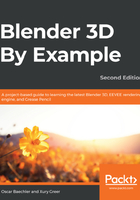
Adding the studs
If there's one thing we know about helmets, it's that they look cooler with pyramid studs, especially if they go all the way around the metal rim. We're going to use a couple of advanced techniques to make selections and create the studs.
In 3D modeling, we have a very useful topology concept called Edge Loops, which we will learn about in more detail in the next chapter. Basically, an edge loop is exactly what it sounds like: a loop of edges that run through a model. If the model has good topology (like our Viking Helmet), there will be clean edge loops all over the model. We can use these loops to our advantage in our modeling process. Let's use them to start modeling the studs:
- Switch to Edge Select mode by pressing 2 on the keyboard.
- Hover your mouse over the middle horizontal loop of the Viking Helmet's base.
- Hold down the Alt key and click on any one of the horizontal edges in the loop.
The whole loop will be selected with just one click, as shown here:

Next, we want to select a part of the vertical loop that crosses over the middle of the helmet. We have to use a different method this time because the vertical edge loop runs all the way through the nose guard and underside of the helmet, which isn't ideal. Instead, we're going to use a wonderful selection feature called Shortest Path:
- Hold down the Shift key and click to add the first edge in the vertical edge loop to the current selection, as shown here:

- Use the middle mouse button to rotate the view to the back of the helmet.
- Hold down the Ctrl key and click on the final edge in the vertical edge loop (it's in the same position as the first, but on the opposite side).
Perfect – the shortest path between the two edges has been added to the selection. Now, our selection includes a horizontal edge loop around the rim and part of a vertical edge loop across the top of the helmet, as shown here:

Selecting these edges by hand would have been a pain, but with the right approach, we were able to select them all in just three clicks.
We're going to use the vertices in this selection as center points for our studs, so let's switch to Vertex Select mode:
- Press 1 on the home row of the keyboard to switch to Vertex Select mode.
That's good, but that's going to be way too many studs, so let's remove some of the vertices from the selection. Specifically, we want to remove every other vertex. That sounds like a pain, but fear not – we don't have to do that by hand either!
- Go to the Select menu in the header of the 3D Viewport.
- Choose Checker Deselect, as shown here:

Good – the selection should now look like this:

If your selection is offset from the example shown here, then we need to make an adjustment to the Checker Deselect operation by using the Adjust Last operation, just like we did when we had to edit the parameters of the Symmetrize operation earlier in this project:
- Have a look at the Adjust Last Operation panel in the bottom-left of the 3D Viewport.
- If needed, increase the Offset to shift the selected vertices until they match the ones shown in this example.
There we go – that will make for a more manageable number of studs. Now that we've selected all of the individual spots where our studs should go, we're ready to actually make the studs:
- Open the Vertex menu in the header of the 3D Viewport.
- Choose Bevel Vertices from the menu:

This operation works similarly to how the s hotkey works: you have to drag the mouse to increase the amount of vertex bevel:
- Drag the mouse outward until the vertices split into little diamond shapes.
- Left-click to confirm the operation when the little diamonds match the example shown in the following screenshot:

Now, we just need to turn the diamonds into pyramids.
- Open the Face menu in the header of the 3D Viewport.
- Choose Poke Faces from the menu:

Poking faces sounds dangerous, but in 3D modeling, it's fun! We just need to make one more adjustment in the Adjust Last Operation panel:
- Have a look at the Adjust Last Operation panel at the bottom-left of the 3D Viewport.
- Increase the Poke Offset to make the little diamonds stick out like pyramids. 0.08m feels about right, but feel free to try other values until you get a result like the one shown in the following screenshot:

And there we have it – the Poke added an extra vertex to each face and the Poke Offset raised them up to form the studs. We're done!
That was a lot of work. Now, we just have to wear it proudly! And by that, we mean we have to place the helmet on the dummy's head.